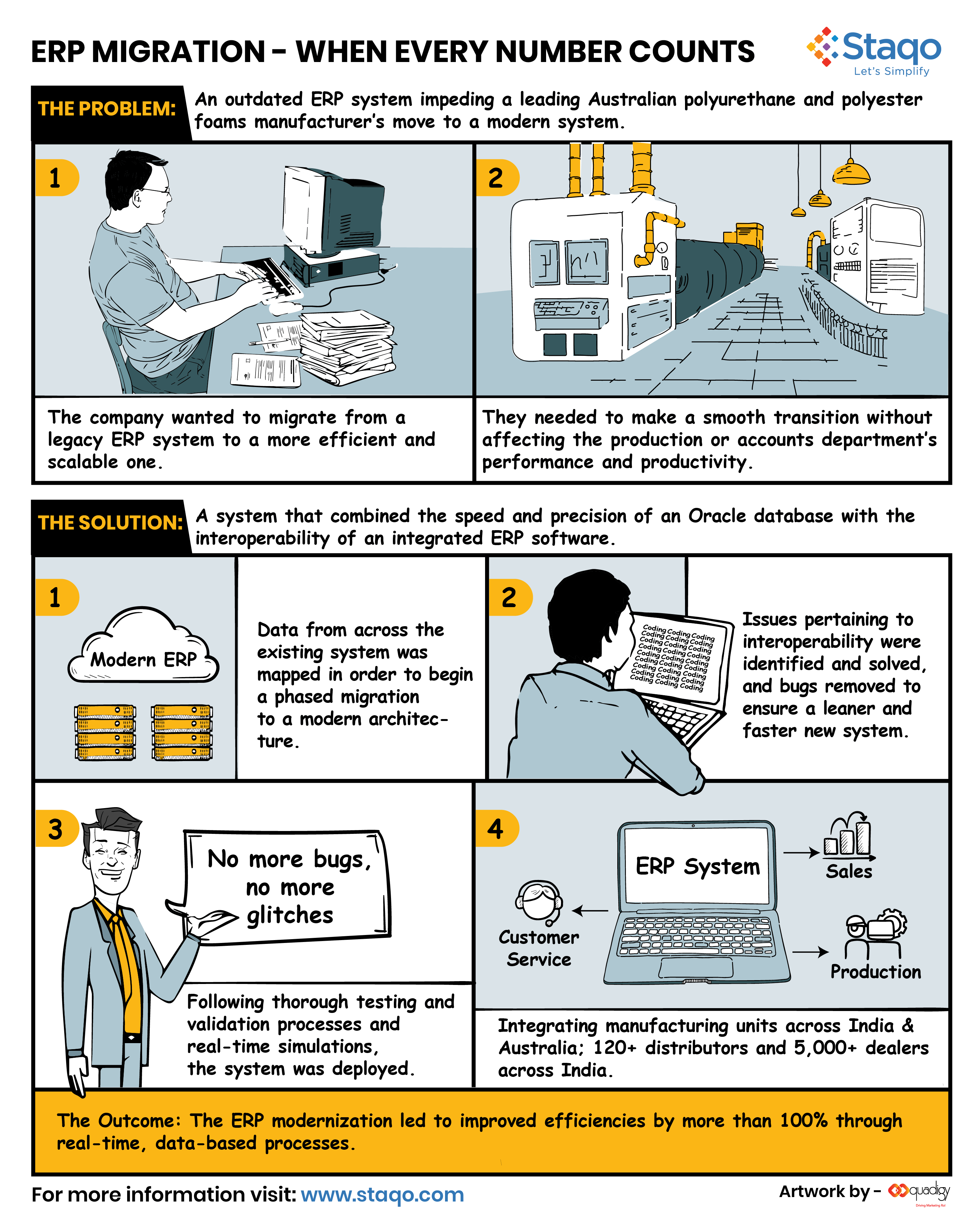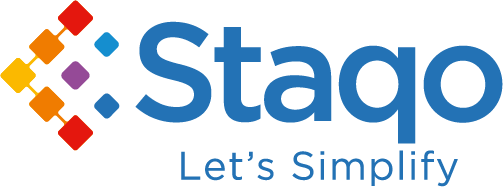Fork-lifting a bulky, and legacy, database system to a new environment can mean all stripes of errors, accidents and downtime incidents. In this case, none of these slip-ups could be afforded. And none of them were allowed.
Has it ever occurred to you during a walk in the park that sometimes ‘staying stuck’ is not a choice but sheer helplessness? When you see someone with a bad knee or a painful denture or a bad haircut, you do not see lack of solutions but fear, hesitation and uncertainty. These forces are always stronger than the hope of a better life, a good run, a limitless smile and some wind in the hair. So, why do so many seasoned people suffer when the chance of getting better, faster and leaner is inches away from their grasp?
Dead-ends of old ERP
Staqo’s team had asked this question several times during its innovation lab sessions. Its IT experts knew the human context of every software way ahead before they wrapped it in a package. So when they sat across a smart team of an Australian manufacturing conglomerate, they knew what the real pain-points were. The business users of the Australian firm, a leading manufacturer of polyurethane and polyester foams for retail and industrial markets, wanted someone deft to handle the overhaul of an ERP system that had been serving its production, purchasing, inventory and accounting functions for twenty years now. But the client’s business users were worried about the human and business implications of this lay-over. They had heard horror stories of ERP migrations gone awry and running way past their budget and time boundaries. This was a company that had built a stellar reputation for its product excellence, delivery rigour and time management. They could not let an IT change ruin it all.

They had come to a fork in the road with a big business strategic change. Staqo’s client’s acquisition of the Australia firm had unlocked an IT opportunity too. This was the perfect time to phase out a 20 years’ old legacy system to a new-age ERP that would allow it to modernize to the same level of agility as SFL homegrown-system had enabled the India operations so far.
The Australian’s team had to get rid of the old MS-DOS database. They had to adapt to the Microsoft Windows shift that 2007 was underlining for every enterprise infrastructure. They wanted to get the speed, clarity and precision of an Oracle database and an integrated ERP software. But how? Could it be done without any inventory, machines and manpower lying idle?
Could they slide over to a new place without:
- Complications and some high-maintenance fine-print
- Sudden surprises and chaos
- User-side confusion and training gaps
- Unwieldy costs, server loads and risks
- Any reliability, availability and consistency breaks
And above all, the migration had to happen in three months. Without any downtime!
Carving the fit right
Staqo undertook a detailed, and clever, diagnosis of the scenario. Its deep-dive analysis covered all possible ramifications of an ERP switch-over. If the jump happened smoothly, some crucial areas would need to be ready to take over once the green button flashes. If there were any hop-over issues, the ripples could be felt into some other areas and operational functions. If the team went for parallel or phased-rollover, then the scenario would have a different set of complications.
The cut-over had to be sharp and smooth without forcing anyone at the shop-floor or the accounts department to twiddle their thumbs and wait for the lights to flash again. So the team designed a careful, and wall-to-wall, ERP migration plan.
It covered the DOS issues first, and took care of data input, master data taxonomy, interfaces, import and export components. It laid out a smooth bridge to an Oracle environment with all the requisite architectural changes. It gathered and categorized information on core and historical data in a proactive way. This entailed close attention to every minute possibility around neat system-of-records, data cleansing, third-party integrations, scope of data conversion, functionality failures, data corruption, downstream issues etc. It also put in ruthless measures to inject the right data ownership and to avoid transfer of unnecessary or corrupt data into the system. This part also meant that adequate measures for standardisation and uniformity were taken because a wide array of data sources and functions were involved in this migration.
So the migration project had four key goals:
- A thorough go-live that covered all data, functions and users defined in the scope
- Minimum operational disruption
- No schedule or cost-creep situations
- No duplication, latency or redundancy
Thus, the team went ahead with careful data mapping and used this exercise as a great way to empower the company with a clean house as far as old data was concerned. Simultaneously, but in a phased manner, the team carried out the execution of the ERP migration to the desired system. This process took due cognizance of many hidden issues like interoperability, bugs, updates, visibility and new skills. This is why a significant part of the initial track went into testing and validation processes. Any trouble-shooting needs were identified, and addressed, before the actual go-live. The test-pilots tried to stretch their coverage to as much real-time simulation as was possible with a stage-by-stage approach to all business and IT scenarios. Also, the switch-over was cleverly planned to not coincide with any critical business peak or demand flux.
The entire journey was planned with meticulous attention to anything and everything that could go wrong – so that it went right. There was no scope for unplanned failures or operational paralysis. Critical integration issues were detected much before they go out of control. What is remarkable here is that no corners were cut in the pursuit of these tough goals. Ample space was provided for future upgrades, scalability and elasticity of the system.
The idea was to make the ERP less of a transactional back-end and more of a digital transformation enabler that did not impede, but accelerated, the growth of business.
Ta-Da!
This turned to be a classic example of successful implementation of a homegrown ERP (Greatplus), which not only connects but integrates businesses. All the company’s units across India, five units in Australia, 120-plus distributors and 5,000-plus dealers across India started reaping the benefit of the same IT infrastructure and IT solutions. They worked on the same platform and were able to integrate and expand geographically. It emerged as a smooth web-based system that was not only process re-engineered to the best levels but also improved efficiencies by more than 100%. It integrated with sales team and at the same time, aligned well with customers through real-time, data-based processes.
At the final leg of the entire exercise, the users were surprised, and thrilled, to see that they were staring at a newly-minted ERP and database system. But it all seemed to have happened in the blink of an eye! The operations and business processes were not halted for even a minute. It was all fluid and uneventful.
The only criticism that such a team gets is – well, that was a tad boring. No fires. No landmines. No missing pulse. No drama. Specially for a project that sounded like a big-bang migration at the outset.
But that’s how IT should be. Throbbing fine as if nothing has happened. Do the big thing, but by going through every detail.
Staqo achieved this implausible outcome with confidence and readiness – and that’s what you should remember when you plan to shift any IT cardboard boxes from your business rooms next. Do not suffer. Get that IT haircut or new set of teeth before it is too late.

